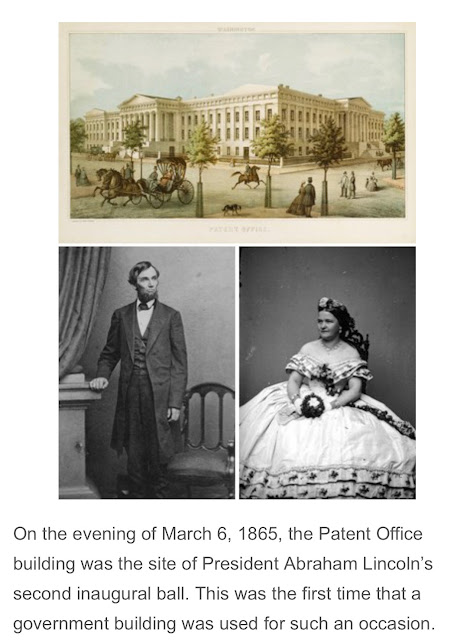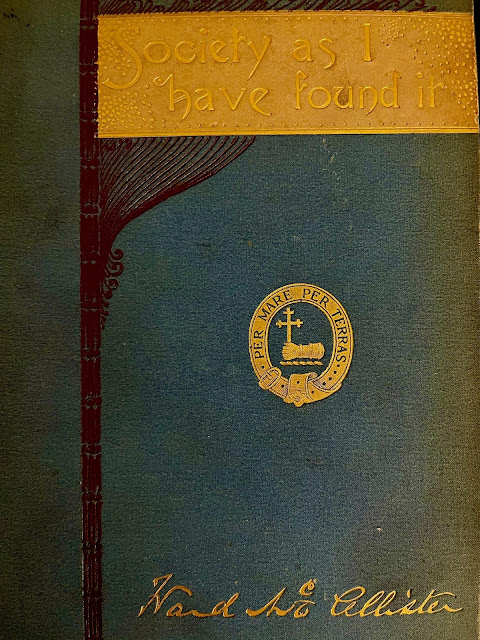 |
| The American people, in general, we are ashamed to say, have not yet learned how to behave at table; and that species of etiquette, not too prevalent in private, is certainly always absent at public suppers. So it was not strange that we should have had warning visions of a grand rush, then a crush, and a demolition in the twinkling of an eye of all the confectioner's handiwork, the frantic snatching of viands from the tables, the brandishing aloft of wine cup, and plate, and cutlery, laden with articles alike dangerous to toilet and stomach; of munching and crunching sans ceremonis; of defilement and ruin to precious apparel, the result perhaps of weeks of the dressmaker's effort; of the loss of temper, and loud cries of complaint. And indeed we harbored a a fear as a consequence that a graceful assemblage of dignified ladies and gentlemen might be transformed, as if by the wand of some evil spirit, into a social raffle, where he who was rudest should be most successful in appeasing the cravings of the appetite, and in pocketing the delicate ornamentations of the table. – Photo courtesy of the National Park Service |
The Washington “season” is past, and there certainly could not have been a more magnificent nor graceful finale; not alone to the Winter's gaities, but to the ceremonies which have made Abraham Lincoln our President again for the next four years, than the time-honored National Inauguration Ball which came off last night; and it is entirely appropriate that not alone with firing of cannon and waving of banners, in which men alone participate, but with music and dancing should we meet and celebrate this signal occasion, when the gentlemen are expected to be as gallant, and the ladies as lovely as possible.
The marble halls of the Patent-office were selected as the most commodious and best adaped in the city. The hall appropriated to dancing is two hundred and eighty feet long, by about sixty feet in width; and the floor is laid in large blocks of blue and white marble. Its decorations were really beautiful -- emblems, banners and devices being tastefully disposed on the walls, while the elaborately frescoed ceiling imparted an air of decided grandeur. Among the decorations the American flag was most prominent, while the various flags of the different army corps formed an appropriate accompaniment. A gallery at the east end was occupied by a fine brass band, which gave music for the promenade, while in the centre, on the south side, a splendid string band furnished music for the dance.
Beside this spacious hall, a wing, three hundred feet in length, was appropriated for the promenade, and a corresponding one on the opposite side for the supper-room. The music was excellent, and had the several halls and the entire building been thoroughly lighted, which they were not, the effect would have been much finer. But gas is certainly not good in Washington, though said to be very abundant. On a dais, at the northern side, were sofas and chairs in blue and gold for the President and family.
All the arrangements see med to be under the management of capability and distinction. The tickets for the ladies were very elaborate and prettily designed, six by ten inches in size, and ornamented with portraits of the President and Vice-President, beside two very good likenesses of the American eagle.
As early as 9 o'clock the carriages began to arrive, and soon the ball-room was thronged. The excellent bands of music soon set the lovers of Terpsichore into the graceful mazes of the dance. At about 10:30 o'clock an avant courrier cleared the way from the main entrance, when His Excellency, accompanied by Speaker Colfax, entered the hall. Following was Mrs. Lincoln upon the arm of Senator Sumner. They walked down the centre of the long hall, and turning at the upper end returned mid-way to the dais, when they became seated. Mr. Lincoln was evidently trying to (throw off care for the time; but with rather ill success, and looked very old; yet he seemed pleased and gratified, as he was greeted by the people. He wore a plain black suit and white gloves.
Mrs. Lincoln looked extremely well, and was attired in the most elegant manner; her dress was made of white satin, very ample and rich, but almost entirely covered by a tunic or rather skirt of the finest point applique. Her corsage, which was low, and the short sleeves, were ornamented richly by a Bertha collar made of the same material, and the shawl, also of the same rich lace, was most exquisite. Passementerie of narrow fluted satin ribbon and nouds completed the dress. Her jewels were of the rarest pearls, necklace, earrings, brooch and bracelets. Her hair, which was put plainly back from her face, was ornamented with trailing jessamine and clustering violets most gracefully. She looked exceedingly well with her soft, white complexion, and her toilet was faultless. Her manners are very easy and affable.
Mr. Robert Lincoln, a fine-looking young man, wearing the uniform of a Captain in the regular army, was also present.
About 11 o'clock Secretaries Seward, Welles, Attorney-General Speed and a large number of diplomats, accompanied by their wives and daughters, made their appearance. Mrs. Secretary Welles, a lady of rather petite figure, was dressed in a mode-colored silk, with black lace shawl. Mrs. Secretary Usher, of about the same stature, wore a rich dress of garnet satin, very plainly but richly made. Mrs. Postmaster- General Dennison, who is a very fine-looking lady, wore a most becoming dress of heavy black velvet, brilliant jewels and hair plainly dressed. Her daughter was in white muslin, embroidered with black. Mrs. Fred. Seward, wife of the Assistant Secretary of State, was attired in a pretty rose-colored silk, handsomely trimmed. Mrs. Senator Harris, who has the appearance of a a well-preserved English lady, wore a most elegant dress of corn-colored silk, trimmed with point appliqué. Mrs. Senator McDougall was also richly attired. The wife of our artist Carpenter was dressed in light silk, with a ruche of tulle. One of the most elaborate and rich dresses in the room was worn by Mrs. George Francis Train; it was a very finely plaided blue silk, trimmed with a flounce of thread lace, almost as deep as her skirt, and other laces to match. Her hair was powdered with gold. Mr. Train was also present.
The multitude of recherche dresses worn by ladies of distinction, it would be impossible to enumerate. There was a prependerance of sensible, high-necked dresses; but a few, and some not American, wore corsages shockingly decolettee. Many ladies who wore velvets, moires and heavier silks, dispensed with hoops altogether, thereby displaying their good taste as well as their regard for the appreciation of some approximation to the female form which still inheres or lingers in the mind of man; one, a matron and evidently a Spanish lady, wore a dress of cloth of gold, with raised crimson velvet flowers, such an one as is seldom seen in this country, or afforded, in any other. In her hair she wore a cluster of five or six enormous diamond rings, strung on a bandeau of velvet. Her laces were also of the finest quality. In her hand she carried a large fan of the gayest and most brilliant workmanship, which seemed to give a breeze of a more ardent clime than ours. A moire antique dress, high-necked and ample-skirted, of the most delicate shade of green imaginable, and worn by a young lady, was indeed exquisite; and also a very light lavender moire antique, trimmed heavily upon the skirt and waist with long silver fringe, was superb. Silks predominated over the more airy textures. Diamonds and other precious jewels were worn in great abundance; and rich laces were plentiful. Some ladies displayed the bad taste of wearing their rings over their gloves. Every lady makes the most of her -- " or somebody's else" -- hair, which is frizzed and puffed and curled in the most extensive manner, and is powdered frequently with diamond and gold dust. One dress of mauve velvet, trimmed with deep point lace, we must not omit to mention. It was royal.
Doubtless the shoddy and petrolia family were represented, to a limited degree; but "oil" will tell very soon, as it spreads so rapidly, and cloth not unfrequently makes the man. Tehre were not, however, any colored persons present, as the Washington Secessionists insisted would be the case.
It had been rumored -- and the foundation for the report was only rumor -- that the supper was to be something extraordinary. We were surprised at this, because we knew good taste and modern custom, in small places like New-York, have, of late years, literally eschewed the practice of immense suppers at public balls; and this reform had been necessitated by the fact that such attempts had generally ended in catastrophes to the toilets and tempers of all participants. It was, therefore, with misgivings that we saw it announced that a grand supper would be served in one of the corridors of the extensive building. The American people, in general, we are ashamed to say, have not yet learned how to behave at table; and that species of etiquette, not too prevalent in private, is certainly always absent at public suppers. So it was not strange that we should have had warning visions of a grand rush, then a crush, and a demolition in the twinkling of an eye of all the confectioner's handiwork, the frantic snatching of viands from the tables, the brandishing aloft of wine cup, and plate, and cutlery, laden with articles alike dangerous to toilet and stomach; of munching and crunching sans ceremonis; of defilement and ruin to precious apparel, the result perhaps of weeks of the dressmaker's effort; of the loss of temper, and loud cries of complaint. And indeed we harbored a a fear as a consequence that a graceful assemblage of dignified ladies and gentlemen might be transformed, as if by the wand of some evil spirit, into a social raffle, where he who was rudest should be most successful in appeasing the cravings of the appetite, and in pocketing the delicate ornamentations of the table.
The name of the cuisinier has escaped us, and it is not worth while to hunt it up now. Suffice it to say it was not Delmonico, therefore we did not expect perfection. The hall set apart for supper was the grand corridor in the west wing. The table was set in the centre, and it gave standing-room for about three hundred persons at one time. The cabinets of the works of genius and invention, placed at intervals, served to form alcoves on each side of the supper-table. On one side, some of these were provided with seats; on the other, they were reserved for depositing the extraordinary quantity of material necessary for such a host, and for the operations of the waiters.
The ornamentation of the table, though limited in extent, was in excellent taste, and perhaps quite as profuse as the unfortunately small space devoted to the supper would permit. There were three leading and conspicuous pieces from the confectioner's hands, placed at appropriate points in the centre and at each end of the table; in the centre, our imposing Capitol, perfect in miniature; at one end an exquisite representation of the heroic deeds of the gallant army; at the other, a similar device of the proud achievements of the navy. The representation of the Capitol was admirably executed; no detail seemed to be too minute for imitation. Even the lamps at the entrance seemed to give forth light.
The bill of fare provided a select and tasteful variety, and no better idea of it can be obtained than by inserting it right here verbatim.
Oyster stews, terrapin stews, oysters pickled; beef-roast beef, fillet de beef, beef a la mode, beef a l'anglais; veal -- leg of veal, fricandeau, veal Malakoff; poultry-roast turkey, boned turkey, roast chicken; grouse - boned and roast; game -- pheasant, quail, venison. patetes, patete of duck en galee, patete de foie gras; smoked ham, tongue en gelee, tongue plain; salades, chicken, lobsters; ornamental pyramids -- nougate, orange, caramel with fancy cream candy, cocoanut, macaroon, croquant, chocolate; tree cakes -- cakes and tarts, almond sponge, belle alliance, dame blanche, macaroon tart, tart a la Nelson, tarte a l'Orleans, tarte a la Portuguese, tarte a la Vienne, pound cake, sponge cake, lady cake, fancy small cakes; jellies and creams -- calf’s foot and wine jelly, Charlotte a la Russe, Charlotte a la vanilla, blanc mange, creme Neapolitane, creme a la Nelson, creme Chateaubriand, creme a la Smyrna, creme a la Nesselrode, bombe a la vanilla, ice cream, vanilla, lemon, white coffee, chocolate, burnt almonds, maraschino, fruit ices, strawberry, orange, lemon; dessert -- grapes, almonds, raisins, &c., coffee and chocolate.
This was the programme for the feast. The only thing which did not seem promising was the fact that but three hundred could be comfortably accommodated at one time, while there were five thousand persons to be accommodated, and a large majority of them ladies.
About the hour of 12, the Presidential party were escorted by a private entrance to privileged places. Soon afterward the doors were opened, and a throng of more than a thousand, who had collected at that end of the hall, poured into the supper-room. Of course, when three persons occupy the space barely sufficient for one, a “crush” is the result; and the crush which followed can better be imagined than depicted.
But this was not the worst feature. With that indecency of conduct and want of politeness and etiquette which characterizes many American people at table, and which is the certain accompaniment of a large crowd at a public supper, many gentlemen, and even some of our own sex who delight to be esteemed ladies, seized upon the most ornamental and least nutritious part of the table decorations, demolished them, carried the pieces off in handkerchiefs or crushed them under foot. Then the more substantial viands were served likewise. Large dishes of choice meats, pattetes, salades and jellies were carried off vi et armis into the alcoves, or elsewhere. One gentleman presented a very ludicrous attitude with a large plate of smoked tongue, requiring both hands to hold it, no place to sit down, and no way to eat it! He looked the picture of despair.
In less than an hour the table was a wreck; a few ornaments not destroyed were removed, and the array of empty dishes and the debris of the feast were positively frightful to behold.
The doors were now wide open, and hundreds of ladies in elegant silks, satins and velvets, and gentlemen in dainty broadcloth, surged and struggled back and forth. A few obtained something to eat, others very little, and many more only succeded in ruining their toilets. As much was wasted as was eaten, and however much may have been provided more than half the guests went supperless. But it was a public supper; we were not much disappointed, and though the gentlemen who managed it may have been to blame for the want of room, the fact remains that the supper was a disaster, and detracted from the otherwise pleasant aspect of the occasion.
Up to midnight, there was little opportunity for dancing, owing to the immense number present; but after the departure of the President and party, which occurred soon after 12 o'clock, the assemblage became sensibly smaller, promenading easier, and dancing quite comfortable. Those who love to “thread the mazes of the dance” then indulged themselves to their entire satisfaction, and the ball went on almost until the dawn of day.
Conspicuous upon the floor were the military and naval officers, who seemed to prefer dancing to any other amusement. One set in the Lancers, in which were Admiral Farragut and Gen. Banks, attracted much attention. Among other military and naval officers of distinction on the floor during the evening were Major-Gens. Halleck and Hooker, and Brevet Major-Gens. Webb and Robinson, Brig.-Gen. Harden, and others whose names are forgotten in the recollection of that brilliant throng. Young and graceful Lieut. Cushing was also there, and we learned that he soon expects to unfurl his flag on foreign shores.
The leading men of politics were also there. Secretary Seward, active, agile and graceful, a marked man anywhere. Senators Morgan and Harris, of New-York; Sumner and Wilson, of Massachusetts; Lane, of Indiana; Yates, of Illinois; Chandler, of Michigan; Wilkeson, of Minnesota; McDougal, of California; Nye, of Nevada; Williams, of Oregon; and others. The House was also well represented by Speaker Colfax, and also by numerous members whose names and utterances have so often been printed in the TIMES as to render it unnecessary here. The arrangement of the ladies' retiring-rooms and the gentlemen's cloak and hat-room were among the very best we have ever seen. Everything was safely and degnitely checked, and there were plenty of attendants. The carriage arrangements were also good; and, take it all in all, the whole affair, save the calamity of the supper, was as successful as such a thing can ever be in Washington.
Such an assembly of American ladies, dressed so magnificently, cannot fail to be surpassingly lovely. In no foreign court could such a number of beautiful, graceful and intelligent women be gathered. Well may they shine and rejoice upon such an occasion as this; for well have they done their duty during this terrible war. They have sent their first and latest born, their lovers, husbands and fathers, giving their lives to the sacrifice of liberty and nationality, and as we stood and glanced over that happy, sparkling throng, we thought how many of those smiling lips had grown tremulous as they bade the loved one good-bye and God-speed; how many of those happy hearts had ached through the long absence; how many fair fingers had ministered at home, scraping lint, knitting stockings, or writing to the absent one; or in the hospital with the living and the dying; and it is but meet that now when the voice of peace is being heard in the land, and justice and liberty restored, that they should meet to rejoice and congratulate upon this befitting occasion. The great, warm heart of the nation has little sympathy with that neuralgic nerve which forbids the expression of exuberant feeling at this most suspicions moment. Then let the eyes which have wept by dried and sparkle, and let music fill the air, and ion be unconfined, and, more than all else, let the nation, rejoice in her beautiful, virtuous, Christian women. -E.J.M. — Special Correspondence of the New-York Times. WASHINGTON, March 8, 1865




















